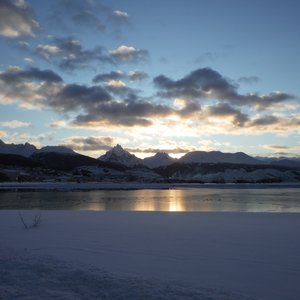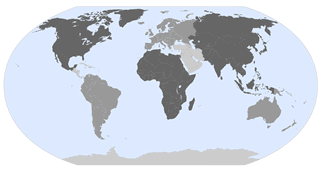Advertisement
Published: September 4th 2015

 Dawn Diving
Dawn Diving
There is a thin film of ice on the waterDIVING FIN DEL MUNDO
Ushuaia, Argentina
The Southernmost City in the World
The snow came down off the roof and crashed onto the sidewalk right outside the door of the house. We managed to squeeze by and reach the door that opened onto the street. Hernan, my host whom I had contacted on Airbnb, had graciously volunteered to drive me to the dive shop. I was excited about diving in Ushuaia, and also a bit incredulous. I didn’t let my mind rest too long on the stark white surroundings.
In the past three days about six inches of snow had fallen. The municipality hadn’t the means, or the desire, to clean the streets yet so taxis were unavailable. We loaded my dive bag into the trunk of Hernan’s car and he jockeyed the auto back and forth, tamping down snow and ice until he managed to pull away from the curb and onto the street. The mountains surrounding Ushuaia on the north were majestic and forbidding in the morning light.
The dive shop is located on a spit of land at the end of a causeway

 Ushuaia Dive Shop
Ushuaia Dive Shop
This was taken several days after the dive day. The snow had melted off the roof.on the west end of the city, and the snow was substantial. There were deep ruts filled with slush that made passage difficult. Thank goodness Hernan’s Audi has a narrow chassis and could slip between the electricity poles and the deep sinkholes that pockmarked the street. We passed the dive shop on our left, nestled in puffs of snow like fluffy white cotton. Hernan had to back up and turn around to access the driveway. Inadvertently he backed the car a little too far and I felt the rear end sink too low to pull back out. Luckily there was another couple in a car to our left and they hopped out and pushed the car back up onto the causeway. Hernan turned onto the road to the dive store and parked in the middle of the parking area. He walked with me to greet Carlos. They shook hands and began talking like old friends. That’s how it is in this small town at the end of the world. I felt a little like a child being deposited in front of a new school. Carlos agreed to give me a ride back to the house after the dive because he
lived less than five minutes from Hernan’s shop. Thank goodness my host would not need to risk the drive again.
I followed Carlos up a short path and into the dive shop that was absolutely toasty due to two large propane heaters. A very attractive young woman named Silvina greeted me. She is a new diver, ten dives only, and is also new to drysuit diving. She is from Brazil, but speaks Spanish and English as well as Portuguese.
After introductions Carlos gave a little dive pre-briefing. I think it was mostly for Silvina’s benefit, as a new diver. He said there were absolutely no creatures to fear in these waters. He said there were not even any fish. Maybe this is because of the many sea lions that live in the surrounding water. He said they might tug on our suits or “mouth” our arm, but they were just playful. Then, he said if we saw the sea lions we should keep an eye on him. If one came at us with his mouth open, or if he signaled to us to go up, we should quickly go to the surface. Then he

 The Dock
The Dock
Look close and you can see the snow on the dock.told us how to identify the leopard seal; dark fur, brown to black, with a white underside dotted with large black spots. These animals are dangerous to divers, and he proceeded to tell us a few descriptive, terrifying stories. Included was the fact that they have been known to grab a diver’s arm or leg and dive down to 60 meters. Deadly. Carlos continued by saying that until several weeks ago there was no problem because the leopard seal only comes to this area in winter, but now we might encounter one due to the drop in temperature. This information supplanted some of our concerns about diving into the 4 degree Celsius water (about 39 degrees Farenheit), but rather than reassuring us, he succeeded in adding one more worry. Was it just to make the dive more thrilling?
We put our belongings inside small hassocks situated in front of the heaters. There were about a dozen red drysuits hanging in an alcove on the back wall; necessary protection for diving the frigid water. BC’s were on the left, and regulators hung on pegs straight ahead. It all looked comfortingly familiar. The suits reminded me of the scarlet

 Silvina
Silvina
What were we thinking?Viking that was my first rubber drysuit, although Carlos’s suits are five millimeter neoprene. He pulled one out for me and I inspected the neck seal, because it looked so dry and old. I told him this seal was useless. He said no, it would be fine, and showed me the others were in similar condition. I was unhappy with them, but he had no others…this is how it is done in Ushuaia, I thought. I had that bad feeling that accompanies suspicion, however. He found another suit for Silvina that looked a little newer. Then he handed out BC’s. I showed him my regulator…Oh! I had left the dry suit hose buried deep in my luggage, since I had been diving a wetsuit the whole trip, and it doesn’t require a hose.
Drysuits have tight seals at the neck and wrists that keep water out of the suit. A hose allows you to put a small amount of air in the suit for buoyancy and warmth. Warm clothing, usually fleece, provides additional warmth. Wetsuits, as the name implies, allow a small amount of water to enter the suit. The body warms the water and insulates the diver. Wetsuits

 Heading to the Dive Site
Heading to the Dive Site
Incredible dive conditions, flat water, no wind, sun.come in different thicknesses; the thicker the suit, the warmer it will be.
Next Carlos checked the hose that attaches to the buoyancy vest (BC) divers use to adjust their weight so they are neutral in the water. My hose worked with his BC thank goodness. My travel BC would be useless with the amount of weight required to sink this much neoprene. He quickly attached a hose, borrowed from one of his regulators, to my unit so I could inflate the drysuit. Then he tested my regulator on one of his tanks. My estimation of him rose when I saw how carefully he turned on the air, saving my regulator and gauges from the usual fast, high burst of air other operators often seem to prefer, and can damage the equipment.
Carlos went on to hand out gloves. They were good quality and new, also quite stiff. He assured me I would be able to take photos despite the thickness of the gloves. Glancing at the snow piled against the walls outside I decided I would probably be happier with all the protection I could. I could see the water in the harbor was covered

 Nice Hat!
Nice Hat!
Our dive boat.in a thin film of ice. Hoods were a good fit and in good condition. I questioned Carlos about undergarments and he told me I wouldn’t need my fleece shirt. Instead he gave me another thin, large, polypro undershirt. Since I wear a neoprene drysuit at home, I should have listened to my gut and put on the fleece. He loaned me a second pair of heavy socks. My “heavy” socks had wear spots on the ball of the foot and the heel that I could read through, but the rest was thick enough to provide warmth.
We suited up, sweating with effort and the heat from the stoves. My sense of trepidation increased when Carlos started wrapping our neck and wrist seals with narrow neoprene “sleeves” and Velcro straps. This is unusual drysuit procedure. My suit had the shortest arms I have ever seen, stopping a few inches above my wrist bone. It was a stretch to just bend my elbows. He said it fit fine. He draped our regulators around our necks and we gathered up our fins, mask, and gloves for the trek through the snowy path to the boat. In addition I carried
my camera and strobes.
When we got to the dock we encountered the scariest part of the dive. Due to heavy seas two days before, the dock twisted to the right and was missing boards in several places. One section was missing about four boards making the opening almost too wide to step across. The whole of it was covered in about four inches of snow making for treacherous footing. The only hand rails were blue nylon rope strung alongside. There was a twelve inch plank over the largest gap. Both my hands were full and I hoped I wouldn’t slip or fall into the water before we left the dock.
Our inflatable boat consisted of two large rubber pontoons with a hard rubber floor between them, or is that a deck? The boat was a zodiac of substantial durability, and was equipped with a wheel stanchion for steering (in some cases zodiacs are steered with a rudder). There was eight inches of snow, still un-shoveled, under the narrow benches that ran along the sides. We stepped in and after loading four dive tanks Carlos aimed the boat toward the Beagle Channel. He showed

 Dock Railing
Dock Railing
Close-up after the snow melt.us how to wear our hood to protect our ears from the cold, but not choke us by pulling it over our head. It was a twenty minute ride to the dive site.
The water was smooth as glass, the spray off the sides of the boat was beautiful and the surrounding headlands and mountains in the distance were breathtaking. Crisp, cold air and snow everywhere filled me with gratitude for this opportunity to dive in Ushuaia, at Fin del Mundo – The End of the World.
Advertisement
Tot: 0.082s; Tpl: 0.012s; cc: 10; qc: 29; dbt: 0.0314s; 1; m:domysql w:travelblog (10.17.0.13); sld: 1;
; mem: 1.1mb










